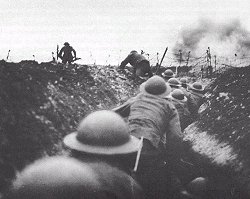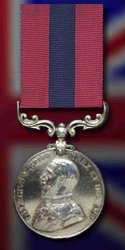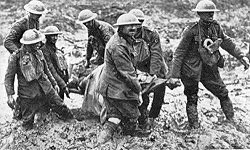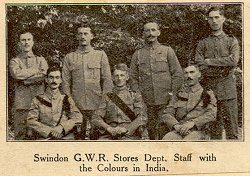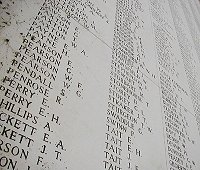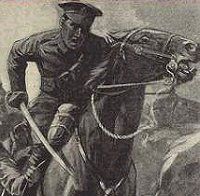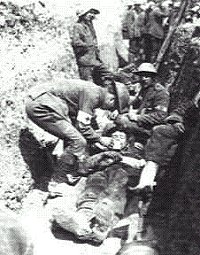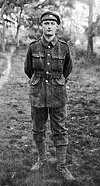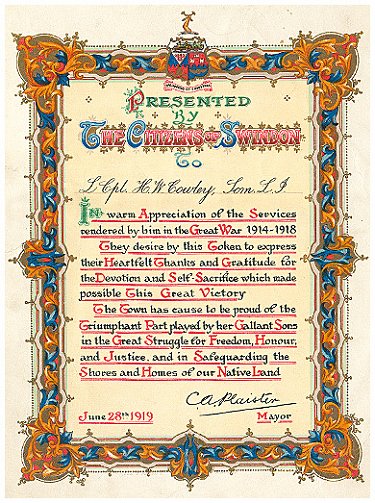Part II - action
Swindon and World War One
Men who worked together and lived in the same town usually enrolled together, fought together and often died together. Many northern towns formed 'Pals' batallions which meant whole communities could be - and sometimes were - devastated if that batallion suffered big losses or even obliteration. Swindon was slightly different because of its link with the regular army in Wiltshire and a strong tradition of part-time or reserve soldiers. This meant that the affects of the war weren't quite as localised as in other towns, but the overwhelming majority of Swindon men fought in one of only five different units and they would have mostly remained with the same comrades throughout the war. So, although it is not possible to track the record of each of the 5,383 Swindon men who fought in the war, we can follow each unit's progress in turn... The Wiltshire Regiment Ten battalions of the Wiltshire Regiment fought in the First World War but the one most associated with Swindon was the 4th Battalion, which included 152 Swindonians at the outset of the war. This battalion saw service in India and Palestine, where a Swindon lad, Pte. JH Woodham, was one of the first to fall. Capt. T.N. Arkell, who was himself wounded shortly afterwards, wrote to Pte. Woodham's parents with the tragic news:
'It is with the deepest regret that I sit down to write and tell you about the death of your son, Private JH Woodham, who was killed this morning. A raid on the Turks had just taken place (which was a great success) and they in return started to shell our trenches heavily at about 4am. Your son was in a trench with three other men, carrying out his duty by standing-to with his rifle-grenades, when an unlucky shell landed in the middle of the trench and exploded. All four were wounded, your son so severely that he died shortly afterwards. It seems an act of Providence that all four were not killed. One of the wounded was Private RM Wills, who also comes from Swindon.'
Fighting in Jerusalem, another Swindon man, Pte. Gosling would receive the Distinguished Conduct Medal (DCM) - the oldest British award for gallantry and second only to the Victoria Cross. Swindon men are also likely to have been included in all of the regiment's other battalions which saw action in Mesopotamia and Gallipoli, but mostly on the Western Front - where it was involved in just about all the major battles in France and Belgium.
This included the notorious Battle of the Somme and also the Battle of Flers - the first battle of any conflict in which tanks were used.
The advent of tanks may have caused shock and dismay in the ranks of the German army, but it was an open secret in Swindon. Incredible as it may seem in our security-conscious times, WD Bavin recalls that: 'Many in Swindon will remember how for several days before the action it was whispered about the town that the Germans were to have an unpleasant surprise; little was said openly on account of the stringency of the military orders, but many had a fairly clear idea of what was afoot and were waiting eagerly for this attack.' Wilts Battery of the 3rd Wessex Royal Field Artillery This territorial (part-time) battery consisted mainly of Swindon men along with some from surrounding areas, and were around 150-strong.
Having been cheered off by crowds on the first day of the war, they eventually found their way to Bombay, following a month-long sea voyage, and stayed in India for three years, forming part of the Vice-regal Guard.
The Hyderabad Bulletin commented on their 'superior physique', attributing this to the fact that they had been 'mostly engaged in engine building'. The Wilts Battery helped repel 'unrest' on the Afghan frontier but its men were in more danger from heat-stroke or disease than Britain's enemies. Swindon men who died from cholera included Sgt. Major H George, son of probably the most celebrated mayor in Swindon's history, Reuben George.
A week later they had another lucky escape when a gas attack was ruined by favourable winds. Their stay in France was limited to six months before they were transferred to Macedonia, to fight the Bulgarians, and then the Middle East, to face the Turks, where Swindon men were part of the division that 'had the honour of being first in Jerusalem' after the Turks surrendered.
Royal Wiltshire Yeomanry Yeomanry were part-time cavalry units whose members needed to provide their own horse - and The Royal Wiltshire Yeomanry are the oldest such unit in the British army. During the First World War the regiment had - and still has - a Swindon Squadron. The squadron was first sent to France in December 1915 and suffered its first casualty in the following February. By June 1916 the entire regiment was in France and, at the beginning of the Battle of the Somme on July 1st 1916, they were stationed near Morlancourt, in the south west of the battlezone, mostly occupied with risky observation work. They remained in the area for the duration of the terrible four-month battle.
The Yeomanry also later fought in the bloody Ypres sector (now called Ieper and always called 'Wipers' by British soldiers) before many were taken prisoner at Morchies during the German offensive of March 1918 which nearly won the war. WD Bavin's book records the names of all 303 Swindon men who were taken prisoner during the war - and two thirds of them were captured in the spring of 1918. Most got home safely, but the book notes that one, Pte. Eveleigh, died of starvation on the way home and another, Pte. CE Haggard, died suddenly, three weeks after returning. Swindon Royal Army Medical Corps (RAMC)
They were drafted to various hospitals across England and although they were never sent overseas as a unit, individuals or small groups were posted abroad and saw service in France, Mesopotamia, Russia, Macedonia, India, Jerusalem and even Sierra Leone. One of them, Mr PF Arnold, son of the manager of Swindon Sewage Farm, was the first to be mentioned in despatches for gallantry in rescuing wounded men. He had been present at various key battles, including the Battle of Mons, the first major battle of the war.
Wilts (Fortress) Royal Engineers This territorial regiment found themselves working on coastal defences early in the war but were to later come under fire in the Ypres sector. They carried out work on various projects, including a large steel bridge which they built along with New Zealanders, over the Canal du Nord, near Havrincourt, France.
For those who came back...
The following certificate of appreciation was presented to Swindon soldier Harold Cowley, who fought in the Royal Wilts Yeomanry, and was lucky enough to survive fierce action in France and Belgium.
Certificate and medals were given to everybody who fought in the war - over 5,000,000 (not all medals were for valour). It is unsure whether this picture was taken in France or Swindon, as soldiers often wore their uniforms at home when on leave.
|
|
||||||||
|
Swindon and World War One |
||||||||
|
Part I - the War at home |
||||||||
|
Part III - the Works |
||||||||
|
Part IV - Little Known Facts |
||||||||
|
||||||||
|
||||||||
|
||||||||
|
|||||||||





